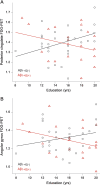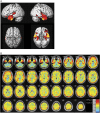Cognitive reserve associated with FDG-PET in preclinical Alzheimer disease
- PMID: 23486873
- PMCID: PMC3691784
- DOI: 10.1212/WNL.0b013e31828970c2
Cognitive reserve associated with FDG-PET in preclinical Alzheimer disease
Abstract
Objective: To examine the effect of education (a surrogate measure of cognitive reserve) on FDG-PET brain metabolism in elderly cognitively healthy (HC) subjects with preclinical Alzheimer disease (AD).
Methods: Fifty-two HC subjects (mean age 75 years) with FDG-PET and CSF measurement of Aβ1-42 were included from the prospective Alzheimer's Disease Neuroimaging Initiative biomarker study. HC subjects received a research classification of preclinical AD if CSF Aβ1-42 was <192 pg/mL (Aβ1-42 [+]) vs HC with normal Aβ (Aβ1-42 [-]). In regression analyses, we tested the interaction effect between education and CSF Aβ1-42 status (Aβ1-42 [+] vs Aβ1-42 [-]) on FDG-PET metabolism in regions of interest (ROIs) (posterior cingulate, angular gyrus, inferior/middle temporal gyrus) and the whole brain (voxel-based).
Results: An interaction between education and CSF Aβ1-42 status was observed for FDG-PET in the posterior cingulate (p < 0.001) and angular gyrus ROIs (p = 0.03), but was not significant for the inferior/middle temporal gyrus ROI (p = 0.06), controlled for age, sex, and global cognitive ability (Alzheimer's Disease Assessment Scale-cognitive subscale). The interaction effect was such that higher education was associated with lower FDG-PET in the Aβ1-42 (+) group, but with higher FDG-PET in the Aβ1-42 (-) group. Voxel-based analysis showed that this interaction effect was primarily restricted to temporo-parietal and ventral prefrontal brain areas.
Conclusions: Higher education was associated with lower FDG-PET in preclinical AD (Aβ1-42 [+]), suggesting that cognitive reserve had a compensatory function to sustain cognitive ability in presence of early AD pathology that alters FDG-PET metabolism.
Figures


Comment in
-
Cognitive and brain reserve and the diagnosis and treatment of preclinical Alzheimer disease.Neurology. 2013 Mar 26;80(13):1180-1. doi: 10.1212/WNL.0b013e318289714a. Epub 2013 Mar 13. Neurology. 2013. PMID: 23486882 No abstract available.
Comment on
-
Neural reserve, neuronal density in the locus ceruleus, and cognitive decline.Neurology. 2013 Mar 26;80(13):1202-8. doi: 10.1212/WNL.0b013e3182897103. Epub 2013 Mar 13. Neurology. 2013. PMID: 23486878 Free PMC article.
References
-
- Stern Y. What is cognitive reserve? Theory and research application of the reserve concept. J Int Neuropsychol Soc 2002;8:448–460 - PubMed
-
- Stern Y, Alexander GE, Prohovnik I, Mayeux R. Inverse relationship between education and parietotemporal perfusion deficit in Alzheimer's disease. Ann Neurol 1992;32:371–375 - PubMed
Publication types
MeSH terms
Grants and funding
LinkOut - more resources
Full Text Sources
Other Literature Sources
